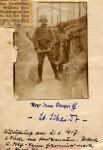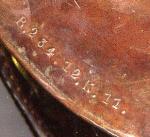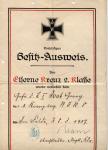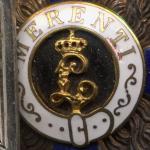-
Posts
29,251 -
Joined
-
Last visited
-
Days Won
84
Content Type
Profiles
Forums
Blogs
Gallery
Events
Store
Everything posted by Chris Boonzaier
-

EK 1914 Missing in action
Chris Boonzaier replied to Chris Boonzaier's topic in Germany: All Eras: The Iron Cross
Hi, Yup the MVK3 doc is there as well -
What is interestingtonote is that a fraction of these photos are of real Sturmtrupps but just guys in the front line. Scheidts regt used its companies in rotation for assaults. i think this photo was NOT actually taken before the raid, but simply at a quieter time in the treches. The Arty had shot trenches on both sides to pieces before the raid, here in the photo they look to be in real good order. best Chris
-
ahhh, but nowdays we would say they had "issues" and were trying to compensate by overly macho action... I mean, tell dr Ruth there is nothing freudian about the way he is holding that grenade! I hope this approach is of intrest to collectors. Isometimes feel that there are only a few strange fellows intrested in reading the research....
-

Sea Shanties and Songs
Chris Boonzaier replied to Simon F's topic in Great Britain: Research, Documentation & History
"The Saucy Sailor Boy" Yes...well.... sailors.....long time at sea and all I suppose..... Thank god for the Infantry........ ;-) -

EK 1914 Missing in action
Chris Boonzaier replied to Chris Boonzaier's topic in Germany: All Eras: The Iron Cross
Ohhh, youre just saying tht to be nice -

EK 1914 Missing in action
Chris Boonzaier replied to Chris Boonzaier's topic in Germany: All Eras: The Iron Cross
I dont want to sound like an ass.... but what in gods name was that written with !!!!!! I assume it was the family, no collector could have done that.. could they ????????? -
Whereas the Imperial Iron cross book will have more examples of EK docs than any work to date, there will not of course be space for pages of research, it is not the purpose of the book. We hope to be able to bring you all that research in the form of a web site that will give the reader/researcher/collector the oportunity to enjoy the documents WITH the story. In that respect the website will be a continuation of the book allowing us to handle subjects in detail that print would not allow. I think it will in the end allow the whole Imperial Ek subject to be handled ... well... like never before. (Yes, I know, this is not an EK doc, but it is a footnote to the subject. We want to try and handle the EK docs in similar depth.) Best Chris
-
And kindly given a once over by Nick, the story of the raid..... After hard fighting in Verdun in 1916 and in the Champagne in 1917 the I.R. 159 found itself in line to the Northwest of Epoye, opposite a French position nicknamed the "Pestbeule" or "Plaguewart". In June of 1917 the division undertook "Operation Rosenbl?te", a large scale trench raid with the goal of destroying the facing enemy positions. Lt Scheidt who had survived the terrible fighting at Verdun the year before was to lead one of the regimental Sturmabteilung consisting of two Sturmtrupps An adapted translation from the Regimental History describes the action. In the front line all efforts were concentrated on the approaching "Opertaion Rosenbl?te". Nightly patrols were sent out to determine the condition of the enemy positions. The medium Minenwerfer blew gaps in the barbed wire and artillery and Minenwerfer discreetly ranged in on their targets for the coming raid. The Sturmtrupps were formed, their objectives discussed and the assault practiced on a model of the French position built behind the German lines. This time it was the turn of the I. and II. Batl. to provide the men. At 11:30 pm on the 15th June 1917 the right flank of the I/I.R. 159 made a feint against the French position nicknamed "Pestbeule". The goal was to attract enemy artillery fire in order to help locate the enemy batteries. After a short bombardment by their own artillery, groups of infantry worked ther way forward, as if to engage in a trench raid. The French response was some weak artillery and machine gun fire, this later increased to light, medium and then heavy artillery fire on the German positions. The lines of communication to the rear were under heavy French fire for the duration of the night. German observers succeeded in pinpointing a number of enemy gun positions and earmarked them for destruction, in the bombardment planned for Operation Rosenbl?te. By the time the evening on the 21st arrived all preparations for the raid had been completed. In the K-1 trench facing the "Pestbeule" six Sturmtrupps were ready, two from the R.I.R. 53 and four from the I.R. 159. Each Sturmtrupp consisted of an officer, a Vizefeldwebel, 2 Unteroffizieren and 20 men. Commanding the patrols of the I.R. 159 were Lt. Beuther (1. Komp.), Lt. (3. Komp.), Lt. d.Res. Stiller (7. Komp.) and Lt.d.Res. Rhoden. Each of the groups had an older officer of the I. Batln in the trench to see the raiding parties off and runners to carry messages incase the field telephone lines were damaged. There was also a Minenwerfer officer supporting each of the groups. In case of emergency there was a reserve of one officer, two Unteroffizieren and fifteen men waiting in position in the trench ready to reinforce patrols if needed. A number of liason groups were formed, each with an Unteroffizier and 6-8 men, their task was to secure ?No Mans Land?, keep contact between the patrols and escort back any prisoners. At each jump off point, there were two machine guns which were to provide supporting fire. On the flanks of the attack were two small searchlights, which would provide a marker to aide the returning patrols find their way home. In neighbouring sectors machine guns would provide support fire to distract the enemy. Also planned as a diversion were bombardments in the neighbouring 13. R.D. sector on Fort Pompelle and on the "Langen Rucken" opposite the 4. I.D. The objective of the raid was not only to take prisoners and capture material but also to cause as much destruction as possible. For this purpose the men were laden with explosives and equipment which was needed for destroying enemy positions. Preparing the way for them were twelve light, fifteen medium and nine heavy calibre Minenwerfer who would drop fire 6000 rounds on the enemy positions, along with 12 artillery batteries of all calibers with a total of 2000 rounds. Added to this were a number of other batteries who were to fire green cross gas shells on the French artillery positions. The patrols were waiting impatiently in the frontline (Abteilung Beuther was crouching in an abandoned trench in No Mans Land) when at 10:05 p.m. the artillery and minenwerfer opened the bombardment. The men had not experienced a supporting fire this heavy since their days at Verdun. There was a deafening thunder of guns behind them and a sea of explosions in front of them on the "Pestbeule". It was a concert show that could only be enjoyed by those who were not on the receiving end of the explosions. Officers and men peered out of their trench, staring at the torn up night sky over the enemy positions. The enemy would not be long in answering. Below is a description of the events in front of the 1. Batl. sector, as seen by an artillery observer. 10:05 Fire by own artillery and minenwerfer 10:12 Our fire moves forward 10:14 Enemy fire, medium calibre, on our second line 10:15 Sporadic light caliber shells in front of and behind our second line 10:16 Sporadic light caliber shells on our second line 10:20 Our fire moves back again 10:23 White flare south of Prunay 10:25 Enemy barrage livens up. Our machine guns open up 10:27 Our artillery and M.G. fire on enemy front line 10:28 French call for barrage in front of their position, 3 yellow flares in front of our 1. Komp. 10:29 French call for barrage in front of their position, 3 yellow flares in front of our 3. Komp. 10:30 Enemy M.G. fire, renewed calls for barrage in front of 3. Komp. Our own arty and M.G. on enemy rear lines 10:33 3 yellow flares calling for barrage to the left 10:34 3 yellow flares calling for barrage to the right 10:36 Enemy M.G. fire 10:37 Enemy flares to the left 10:38 Enemy M.G. fire 10:41 To the left of Prunay enemy munitions dump explodes. White flares to the left 10:44 Barrage signal to the right of Jonasweg. Enemy M.G. fire in front of 1. Komp. 10:45 Enemy heavy shells on our third line. Enemy M.G. fire in front of 1. Komp. Enemy light and heavy shells on our first and 2nd line. 10:47 Enemy M.G. fire in front of 1. Komp. 10:50 Enemy M.G. fire in front of 3. Komp. White flares to the left. 10:51 Enemy M.G. fire. 10:52 German pilot over 3rd line shooting tracer 10:54 3 white flares to the left 10:55 Enemy M.G. fire in front of the 1. Komp. 10:56 Enemy M.G. fire in front of the 3. Komp. 10:57 Enemy M.G. fire in front of the 3. Komp. 10:58 German aircraft leaves 11:00 German aircraft arrives again. French flares call for more barrage fire. 11:01 Very lively enemy M.G. fire in front of 1. and 3. Komp. 11:07 German ilot shoots tracers 11:08 Enemy M.G. fire 11:11 Enemy M.G. fire in front of the 3. Komp. 11:12 White enemy flare in front of 1. Komp 11:14 Enemy M.G. fire in front of 1. and 3. Komp. 11:17 Enemy M.G. fire in front of 1. and 3. Komp. 11:20 Enemy M.G. fire in front of 1. and 3. Komp. 11:25 Enemy white flare to the left 11:27 2 enemy flares in front of the 1. Komp, one by the R.I.R. 53 11:28 Enemy artillery fire moves to the rear 12:17 4 yellow flares fired by us. For the raiders themselves the event passed as follows. At 10.30 p.m. the Abteilungen under Rohden, Stiller and Scheidt left their launch stations on the front line. The columns of helmeted Sturmsoldaten with their rifles and grenades were soon swallowed up by the darkness. For a moment their light armbands could be seen, a soft clanking was heard, and then they were gone, as were the liaison men wearing their two white bands of recognition. A couple of minutes later the Sturmtrupps were through the wire and into the enemy positions. Although the enemy shrapnel had whistled past their ears while they were crossing ?No Mans Land?, and the Stiller patrol had had to leave two wounded behind, the patrols had advanced rapidly. Only the Abteilung Beuther could not move forward, they were trapped in the old trench they had chosen for a launching point, the enemy?s barrage was concentrated right in front of their position. To advance would have meant the destruction of the Abteilung and Beuther took the initiative to stay put with his men. In the meantime the other Abteilungen (including two of the R.I.R. 53) were advancing over the first enemy positions. The trenches of the "Pestbeule" had suffered terribly under the German medium and heavy fire. From the destroyed positions screams and moans echoed up from the buried enemy soldiers. Patrol Rohden captured nine Frenchmen from two bunkers which had survived the bombardment, they surrendered without opposition. The patrol pushed on to the "Runden Wald". Here they turned around and headed back. An enemy assault group appeared out of a bunker and chased them, throwing hand grenades. But they suffered no losses and managed to return with their prizes. Other than the prisoners, these prizes included two automatic weapons. Patrol Stiller also managed to reach its objective, but only managed to take one prisoner, who somehow managed to escape on the way back. Abteilung Scheidt brought back two prisoners. They had tried to fight their way to the enemy?s 3rd line, but had to stop when they ran into a wall of splinters caused by their own artillery and Minenwerfer fire. During their advance they had neutralised the occupants of numerous bunkers who had refused to surrender. Just after 11.00 p.m. all the troops were back in the German lines. Group 1 of the R.I.R.53 and taken sixteen prisoners and an automatic weapon. All in all twenty seven prisoners from the French 28th Territorial Regiment and one from the 277th infantry Regiment were taken. The operation was a resounding success, the enemy positions were destroyed. The bloody losses of the enemy must have been as many as there were POWs. There would have been more POWs if the artillery preparation had not been taken so long. It can be speculated that, which had crept backwards and forwards, had actually allowed enemy soldiers to escape to the rear, instead of forcing them forward as it was intended to do. The Aeroplane firing tracer had influenced the enemy?s morale to a small degree according to information given by the prisoners. The raid showed that the enemy had adapted to the German raiding tactics. (As the Germans also did) the soldiers had been ordered back to avoid the attack and had advanced in a counter attack (but fortunately too late to catch the Germans). Their barrage had also been more concentrated than in the past. No long term effect was noticed. After the raid the enemy continued his business as usual.....
-
This is just some rough work. as some of you know, a few of us are working with Gordon on the Imperial iron cross book, but there is more to it than that, there will be a website to the book (as part of a larger website project) as well, and Nick has allowed us to use GMIC as a forum for any discussions and questions folks may have concerning the two. The main web site will have a number of different sections, including one on Trench raiders, patrollers and Sturmtruppen. I thought I would give you an idea of what we are aiming at by posting lt Scheidt and the research into his document... Here he is before the raid.... Grenades, pistol, knife and no dogtag...
-

EK 1914 Missing in action
Chris Boonzaier replied to Chris Boonzaier's topic in Germany: All Eras: The Iron Cross
Nice stuff, I also have a doc to that regt, and the Sommer one to the company that was swept away in the face of the attack... Would make a nice self contained chapter :-) -

EK 1914 Missing in action
Chris Boonzaier replied to Chris Boonzaier's topic in Germany: All Eras: The Iron Cross
Of course, the big advantage German collectors have over those who colect British medals, the dealer was not interested in the contents at all, just the print style of the EK doc. If it were a Brit group something like that would raise the price by 3 or more times the face value. -

EK 1914 Missing in action
Chris Boonzaier replied to Chris Boonzaier's topic in Germany: All Eras: The Iron Cross
-
I am working on a number of projects with GMIC folks at the moment, including one that will be on researching Iron Cross documents. It should be a great read when finished. This is as yet unresearched, but for the British collectors out there... you know how interesting a first day of the Somme casaulty is.... This is to Gefr Jost... first from his pass... missing in action on the first day of the Somme, the Ulster division wiped out the left flank of his company as they stormed towards the Schwaben Redoubt. He was badly wounded, POW, and came back to germany in part of a POW trade in October 1916 (amputees, blinded etc were sometimes traded back as they could no longer fight.)
-

France The national defence medal (France)
Chris Boonzaier replied to Chris Boonzaier's topic in France
Interesting to see the mix of bar types on the DN. In 50 years a collector will say "An officer would NEVER have done that!! They would have had matching bars!!" :-)) -

EK 1939 cased EK1
Chris Boonzaier replied to Chris Boonzaier's topic in Germany: All Eras: The Iron Cross
I would guess these were left over cases used for 57s? he making style is exactly the same as the style I had a late war znk KVK1 (maker 4) in. The inside (when you prise the bottom out) has the WW2 style stamps and old bone glue, which is long out of date in 1957. Best Chris -

France The national defence medal (France)
Chris Boonzaier replied to Chris Boonzaier's topic in France
Well, I guess the points system is not that great either. """The Bronze class is awarded for 6 months of service AND 90 points (???) - Silver class for 5 years and 600 points (and after having received the bronze class min. 2 years before) - Gold class for 10 years and 800 points (silver class min. 2 years earlier).""" If you count 22 months Operations outside of France you get over 2000 points for that alone, (excluding all other calculations like Helicopter rides and whatever else gets you points), but that is because you get 3 points a day whether you are in Kinshasa or Bangui while on ops, and that be 2 very different places. I think the bronze one looks better anyway, So there ! -

Turkey Turkish delight... and earlier than 1914...
Chris Boonzaier replied to Chris Boonzaier's topic in Türkiye
Hi, I meant local, as in where we are on holiday. the 4th class above cost me USD20 in Cairo, but as the wife would point out, we spent 3 solid days scratching through every market and junk pile to find it. the 5th class I found in Scutari, I had 5 1914 EK2s with me and the turkish dealer was happy to trade, so was I :-) there is something about picking up a Crimean era 5th class just a few hundred meters away from where the lady with the lamp did her thing. Other holiday specials include british Egypt and Sudan medals picked up in Egypt, and a pile of French and spanish colonial stuff from morocco. The Problem is... the wife is dead keen on South America, I try to tell her that militariawise North Africa is a better deal... but she just switches off the "logic" button. South America and Mexico are militaria dead ends unless you live there and have contacts :-( -

Turkey Turkish delight... and earlier than 1914...
Chris Boonzaier replied to Chris Boonzaier's topic in Türkiye
I have a special "holiday" collection as a side line. I cleared it with the wife... I dont want souveniers, I want local medals. Usually i have to go scratching through markets etc. but most of the time I manage to turn something up. Best Chris










